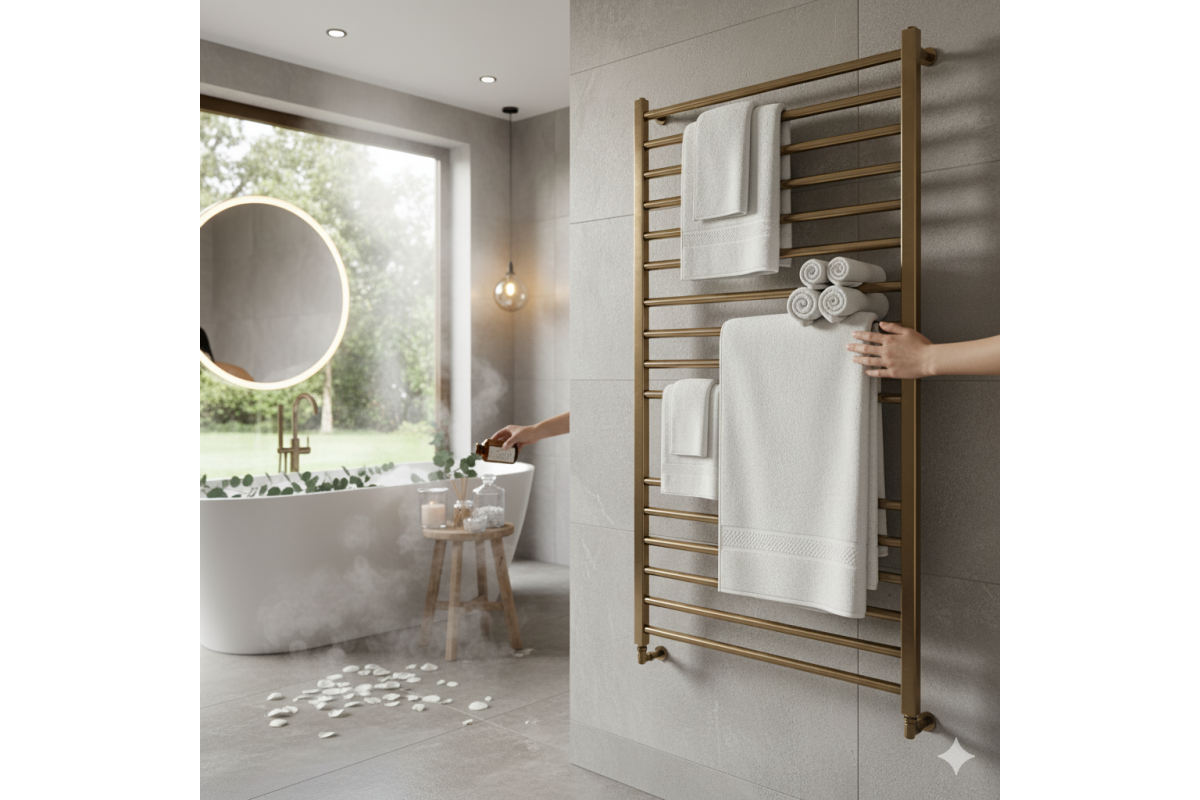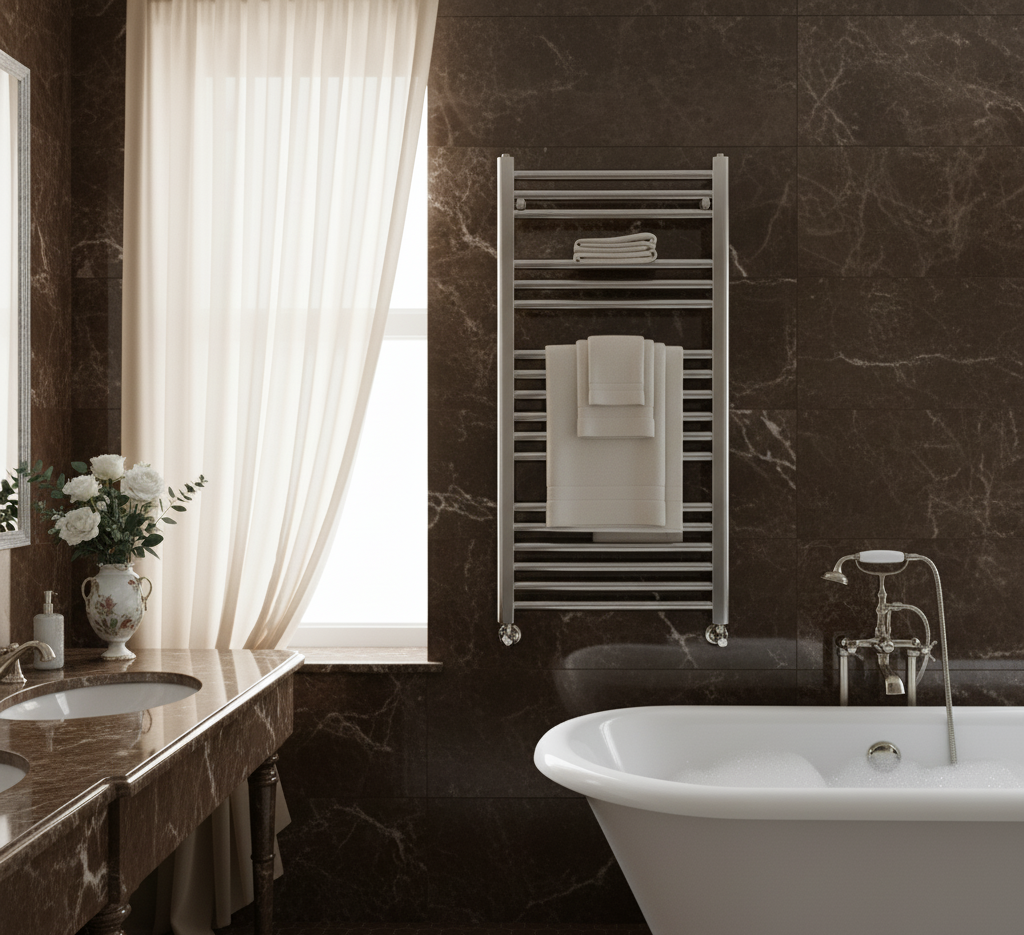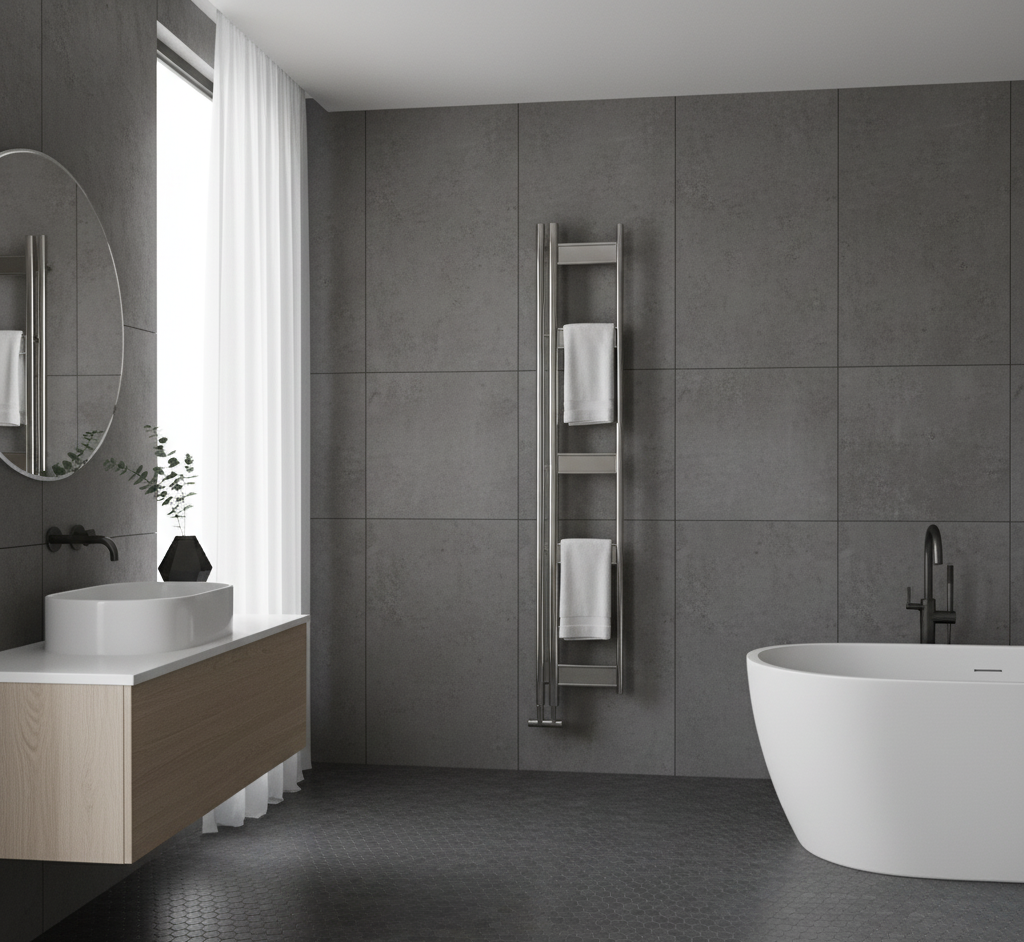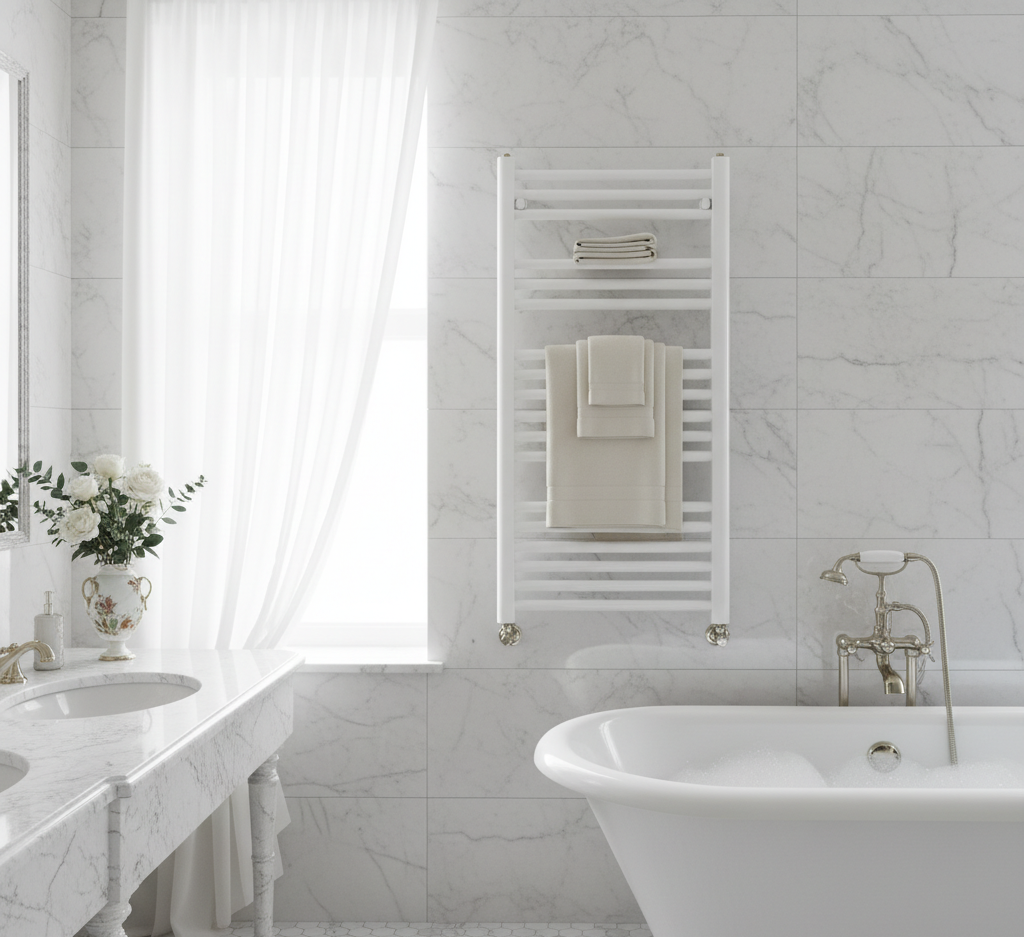The Home Spa Upgrade: How the Right Towel Rail Transforms Your Bathroom Experience

Picture this: It’s a cold, dark winter morning. You step out of a piping-hot shower, only to be hit by a wave of frigid air. You reach for your towel, but it’s still damp and chilly from yesterday. This is the daily reality for many, and it's the very opposite of the luxurious, spa-like sanctuary your bathroom should be.
Now, picture the alternative. You step out of the shower into a room that is already wrapped in gentle, consistent warmth. You reach for a towel that is not just dry, but toasty and fluffy. You wrap it around you, and the chill of the morning melts away. This is the home spa promise, and it’s completely achievable.
For many, the solution seems simple: install a heated towel rail. But there’s a costly secret that many homeowners discover only after installation: the beautiful, sleek rail they bought doesn't actually heat the room. You may have heard the stories or even lived one. A friend replaces their old, bulky radiator with a modern towel rail radiator, only to find they've made a costly mistake that leaves them with warm towels but a "cold bathroom".
Here is the truth: The problem isn't the towel rail. It's the process. The market is full of confusing information, and it's far too easy to buy a model based on looks alone, ignoring the simple physics required to keep a room warm. This guide is designed to stop that from happening. We will show you how to avoid the number one mistake and choose the perfect towel rail. We'll give you the expert knowledge to select a model that not only provides glorious, warm towels but also has the power to turn your entire bathroom into the warm, inviting escape you deserve.
The #1 Mistake: Why Do Towel Rails Fail to Heat a Room?
Let's address the elephant in the room. The cold bathroom myth is born from a real, frustrating experience. A homeowner sees a stunning, slim-line rail, installs it, and finds it's nowhere near the heat output of a normal radiator.
The reason is simple: Aesthetics vs. Physics.
A traditional panel radiator has a large, flat surface area designed to radiate a high volume of heat into a room. A ladder-style towel rail, with its elegant tubes, has significantly less surface area. You cannot simply swap a 1200x600mm panel radiator for a 1200x600mm towel rail and expect the same performance. It's the physical equivalent of trying to heat your living room with a single lightbulb.
The cold bathroom scenario isn't a failure of the product; it's a failure of calculation. The only way to guarantee your new towel rail will heat your room is to choose it based on its heat output, not just its style. And that heat output is measured in BTU (British Thermal Units).
In simple terms, the higher the BTU number, the more heat the radiator can produce. Every room has a unique heat loss value. To make a room feel warm, your radiator's BTU output must be greater than the room's heat loss. That's it. A correctly-sized towel rail, one with the right BTU output for your specific room, will absolutely heat your bathroom.
The 3 Types of Towel Radiator: A Quick Guide
Before you can choose which one, you need to understand the three fundamental types. This choice will affect your installation cost, running costs, and even your ability to have warm towels in the summer.
1. Central Heating (Hydronic) Towel Rails
These are the most common type. They are plumbed directly into your home’s wet central heating system, just like any other radiator in your house. Hot water from your boiler circulates through them, heating the rail and the room.
- Pros: Generally the most cost-effective to run, as they are part of your main (and often cheaper) gas heating system.
- Cons: They only work when your central heating is on. This means no warm towels in July unless you're willing to heat your entire house to do it.
2. Electric Towel Rails
These are standalone units, completely independent of your central heating. They are wired into your home's electrical circuit (a job for a qualified electrician) and are often filled with a special fluid that is heated by an internal electric element.
- Pros: Work all year round. 100% efficient at the point of use, meaning every watt of electricity pulled from the wall is converted directly into heat. Easy to control with timers.
- Cons: Can have higher running costs than central heating models, as electricity is typically more expensive than gas.
3. Dual Fuel Towel Rails (The Best of Both Worlds)
This is the "no-compromise" option that gives you ultimate flexibility. A dual fuel rail is connected to both your central heating (for winter) and the electrical mains via a heating element (for summer). A special T-piece valve allows you to switch between the two.
- Pros: The most convenient and flexible solution. In winter, it runs efficiently off your central heating. In summer, you turn off the central heating valve, flick on the electric element, and enjoy warm towels without heating the whole house.
- Cons: The most complex to install, as it requires both a plumber and an electrician.
A dual fuel setup is the perfect solution for year-round comfort. This Alento Towel Rail 1120 x 530 chrome model is a classic example of a versatile, rail that fits perfectly in most family bathrooms.

Click Here to shop This Alento Towel Rail radiato
How to Choose the Perfect Towel Rail in 4 Steps
Here is the foolproof, 4-step process our heating experts use. Follow this, and you will never have a cold bathroom.
Step 1: Calculate Your BTU (The Most Critical Step)
Do not guess. Do not eyeball it. Before you even look at a single style, you must use aBTU calculator. This simple online tool will ask for:
- Your room's dimensions (length, width, and height).
- The type and size of windows (e.g., single or double-glazed).
- The type of walls (e.g., solid brick or cavity with insulation).
- What's above and below the room (e.g., another heated room or a cold roof).
The calculator will then give you a magic number the minimum BTU output you need to heat that space. When you shop, simply filter for towel rails that meet or exceed this number. As a pro-tip, we recommend choosing a radiator with an output that's about 10% higher than your result. You can always turn a bigger radiator down, but you can't make a smaller one work harder.
Step 2: Choose Your Material (Performance vs. Price)
The material your rail is made from has a huge impact on heat-up time, longevity, and price.
- Mild Steel: This is the most common and affordable option. It's a good conductor and very durable. It is usually finished with paint (white, black, anthracite) or a chrome plating.
- Stainless Steel: This is a premium, buy it for life option. Its key benefit is that it will not rust, flake, or peel perfect for a high-moisture bathroom. It also holds heat exceptionally well.
- Aluminium: This is the modern, eco-friendly choice. Aluminium is a superb conductor, meaning it heats up faster than steel and requires less water, making it highly energy-efficient. It's also very lightweight, making installation easier.
Step 3: Pick a Finish to Create Your Home Spa Look
Now for the fun part! Once you have your BTU and material, you can focus on aesthetics. The finish will tie your whole theme together.
- Classic Chrome: The timeless, most popular choice. It's bright, reflective, and matches any tap or shower. A common myth is that chrome gives less heat. The truth is that the chrome plating process can make it fractionally less emissive than a painted rail of the exact same size, but this small difference is already accounted for in any good retailer's tested BTU rating. If you've matched your BTU, buy the chrome rail with confidence.
- Anthracite & Matte Black: These are the new customer favourites. A dark, textured finish like anthracite or a bold matte black creates a stunning, modern focal point, especially in a monochrome bathroom.
- Brushed Brass: The height of luxury. This "on-trend finish" adds a warm, metallic hue that feels opulent and instantly elevates the space.
For a timeless, classic look, a straight chrome rail is the most popular choice in the UK.

Click Here to shop This Chrome Aliano Towel Rail
Step 4: Get the Right Size and Placement
Finally, where will it go? Don't let placement be an afterthought.
- Size: The size you need is dictated by the BTU you need. If you have a small bathroom with high ceilings, you'll likely need a tall, narrow vertical rail to get the necessary surface area without sacrificing wall space. If you only have space under a window, a wide horizontal towel rail is the perfect solution.
- Placement: For maximum heating efficiency, the best place for any radiator is on the coldest wall typically the external wall or the wall under a window. This counteracts cold draughts at their source. Of course, you also need to balance this with convenience, placing it near the shower or bath so you can easily grab that toasty towel.
For a traditional bathroom, a floor-mounted Alicia Traditional Towel Radiator combines classic elegance with a functional towel rail.

Click Here to View This Alicia Traditional Towel Radiator
Pro-Tips: Installation & Energy Saving Hacks
You've chosen your perfect radiator. Here’s how to install it correctly and use it efficiently to get that home spa feeling every single day.
Installation: Avoid These Common DIY Mistakes
While a confident DIYer with plumbing experience can fit a new rail, we strongly advise hiring a qualified professional. Any work involving electrics (for Electric or Dual Fuel models) must be done by a certified electrician. A registered plumber will ensure your central heating model is connected safely and without leaks.
If you are tackling the job, avoid these common pitfalls:
- Incorrect Bracket Placement: This is the most common error. People fix the top brackets too high, leaving no room to hang a fluffy towel over the top rung. Always position the brackets lower on the rail to maximize hanging space.
- Forgetting PTFE Tape: All threaded joints (like the valve connections) need PTFE plumber's tape to create a watertight seal. Forgetting it will lead to slow, damaging leaks.
- Mismatching "Pipe Centres": If you are replacing an old radiator, you must measure the distance between the two pipe inlets. Your new rail must have the same pipe centre measurement, or you will have to re-do the pipework.
How to Save Money (Should I Leave It On 24/7?)
This is a common question. While you can leave a towel rail on, it is not efficient or cost-effective.
- The Smart Solution (Electric/Dual Fuel): Use a timer switch. This is the single best hack. Set it to turn on 30 minutes before you wake up and 30 minutes before your evening bath. You get the full "home spa" luxury for a fraction of the cost. A typical 100W electric rail, for example, could cost as little as £11 per year if used for 2 hours a day.
- The Smart Solution (Central Heating): Install a Thermostatic Radiator Valve (TRV). This lets you set the bathroom's temperature independently of the rest of the house, saving energy.
- The 5-Minute Fix: If your rail is hot at the bottom but cold at the top, it's not broken it just has trapped air. You simply need to bleed your radiator. Use a radiator key to slowly open the small valve at the top until you hear a hiss. When a drop of water comes out, close it. It’s that simple.
Conclusion: Your Bathroom Transformation Awaits
The difference between a cold, damp utility space and a luxurious home spa isn't a budget-breaking renovation. It's the simple, everyday luxury of stepping into a warm room and being greeted by a toasty towel.
Don't let the cold bathroom myth stop you from completing your dream bathroom. That frustrating experience is completely avoidable when you buy with your head, not just your eyes.
To guarantee your transformation, just remember the expert plan:
- Calculate First: Use a BTU Calculator to find your magic number.
- Choose Your Power: Select your heating type (Dual Fuel offers the most flexibility).
- Choose Your Performance: Pick a high-quality material like Aluminium or Stainless Steel for the best results.
Once you get the technical part right, you are free to enjoy the aesthetic part finding that perfect matte black or brushed brass finish that completes your vision. Ready to find your perfect home spa upgrade? Browse our full collection of towel rail radiators today.
